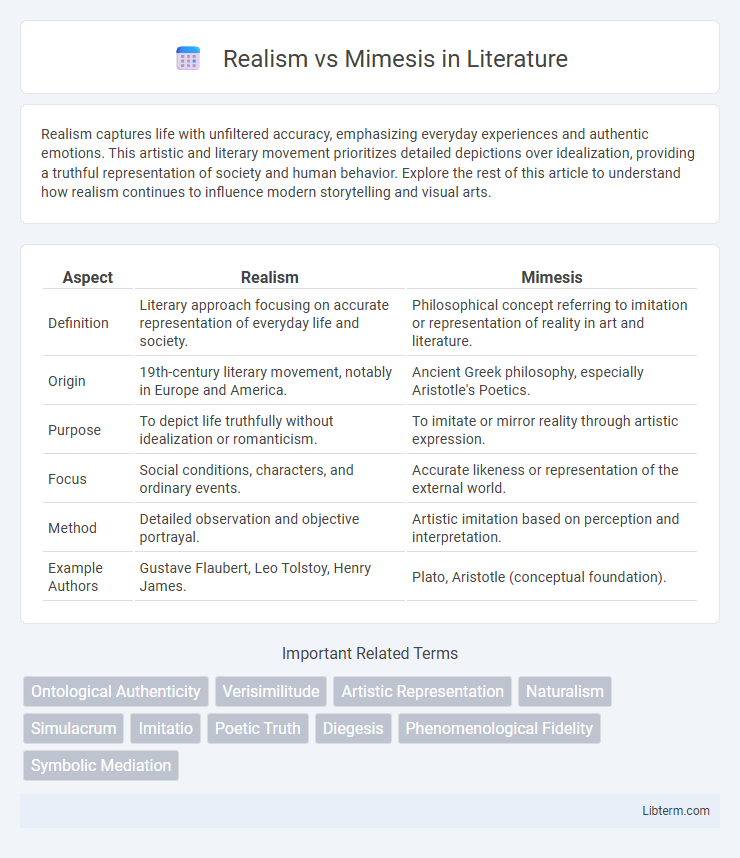Realism captures life with unfiltered accuracy, emphasizing everyday experiences and authentic emotions. This artistic and literary movement prioritizes detailed depictions over idealization, providing a truthful representation of society and human behavior. Explore the rest of this article to understand how realism continues to influence modern storytelling and visual arts.
Table of Comparison
| Aspect | Realism | Mimesis |
|---|---|---|
| Definition | Literary approach focusing on accurate representation of everyday life and society. | Philosophical concept referring to imitation or representation of reality in art and literature. |
| Origin | 19th-century literary movement, notably in Europe and America. | Ancient Greek philosophy, especially Aristotle's Poetics. |
| Purpose | To depict life truthfully without idealization or romanticism. | To imitate or mirror reality through artistic expression. |
| Focus | Social conditions, characters, and ordinary events. | Accurate likeness or representation of the external world. |
| Method | Detailed observation and objective portrayal. | Artistic imitation based on perception and interpretation. |
| Example Authors | Gustave Flaubert, Leo Tolstoy, Henry James. | Plato, Aristotle (conceptual foundation). |
Understanding Realism: Defining the Term
Realism in literature and art prioritizes an accurate, detailed depiction of everyday life, emphasizing authentic characters and plausible events. Unlike mimesis, which broadly refers to imitation or representation of reality, realism strives for fidelity to the social, cultural, and psychological dimensions of human experience. This movement rejects idealization, instead focusing on the truthful portrayal of ordinary circumstances and the complexities within them.
The Origins and Evolution of Mimesis
Mimesis originated in ancient Greek philosophy as the representation or imitation of reality, prominently theorized by Plato and Aristotle, who emphasized its role in art and literature as a reflection of human experience. Over time, mimesis evolved from mere replication of the external world to encompassing a deeper interpretation of truth and emotional resonance within artistic works. Its development influenced various artistic and literary movements, shaping debates on authenticity and representation that contrast with the more objective, detail-driven approach characteristic of Realism.
Realism in Literature and Art: Key Characteristics
Realism in literature and art emphasizes accurate, detailed depictions of everyday life and ordinary people, rejecting idealization and romanticism. Character development, social context, and plausible events are central, reflecting the complexities of real-world experiences. This movement prioritizes objective observation and authenticity, aiming to represent subjects truthfully without embellishment.
Mimesis: Imitation and Representation Explained
Mimesis, central to classical and contemporary art theory, refers to the imitation or representation of reality, capturing the essence of life and nature in artistic form. It emphasizes accurate depiction and truthful reflection, aiming to mirror external reality through literature, painting, and drama. This concept contrasts with Realism by focusing more on the faithful replication of appearances rather than the underlying social or psychological truths.
Realism vs Mimesis: Core Differences
Realism emphasizes the faithful representation of everyday life and ordinary people, aiming to depict reality as accurately and objectively as possible. Mimesis, rooted in classical philosophy, involves the imitation or replication of nature and human behavior, often idealizing or stylizing reality to convey deeper truths. The core difference lies in Realism's commitment to practical accuracy versus Mimesis's interpretive imitation, blending fidelity with artistic interpretation.
Philosophical Foundations: Aristotle to Modern Thinkers
Realism and mimesis trace their philosophical foundations to Aristotle, who defined mimesis as the imitation of nature, emphasizing art's role in representing reality to evoke catharsis. Modern thinkers, such as Martin Heidegger and Nelson Goodman, expanded these ideas by critiquing mimesis as mere replication, instead highlighting art's capacity to disclose multiple realities and symbolic meanings beyond straightforward representation. The evolution from Aristotle's mimetic theory to contemporary realism debates reflects a shift towards understanding art as both an interpretive act and an ontological engagement with existence.
Realism in Visual Arts vs Mimesis in Performance
Realism in visual arts emphasizes accurate, detailed representation of everyday scenes, aiming to reflect reality without idealization, often through precise use of light, shadow, and perspective. Mimesis in performance centers on the imitation or enactment of life, where actors embody characters and emotions to recreate human experiences dynamically for the audience. While visual realism captures static, observable reality, performative mimesis relies on temporal, embodied expression to evoke authenticity and emotional resonance.
The Role of Truth and Authenticity
Realism emphasizes the truthful representation of everyday life, prioritizing authenticity by portraying characters, settings, and events with accuracy and detail. Mimesis involves imitation or replication of reality but allows for interpretative flexibility, focusing on how art mirrors life rather than exact truth. The role of truth in Realism aligns with factual accuracy, while in Mimesis, authenticity is achieved through faithful, yet sometimes idealized or symbolic, representation.
Critical Debates: Realism or Mimesis in Contemporary Works
Critical debates on realism versus mimesis in contemporary works focus on how accurately art represents reality versus its imitation of sensory experiences. Realism emphasizes truthful depiction of everyday life, prioritizing objective social conditions and characters' psychological depth, while mimesis centers on replicating appearances and sensory detail to evoke emotional resonance. Contemporary discussions analyze whether works should prioritize authentic social critique or strive for aesthetic fidelity in representing the human experience.
Conclusion: The Enduring Relevance of the Debate
The enduring relevance of the Realism vs. Mimesis debate lies in its exploration of how art represents reality, either through faithful imitation or interpretive representation. Contemporary discussions emphasize the impact of this dichotomy on narrative techniques, audience perception, and the authenticity of artistic expression. This debate continues to influence fields such as literature, visual arts, and theater, underscoring the evolving relationship between reality and its artistic portrayal.
Realism Infographic

 libterm.com
libterm.com